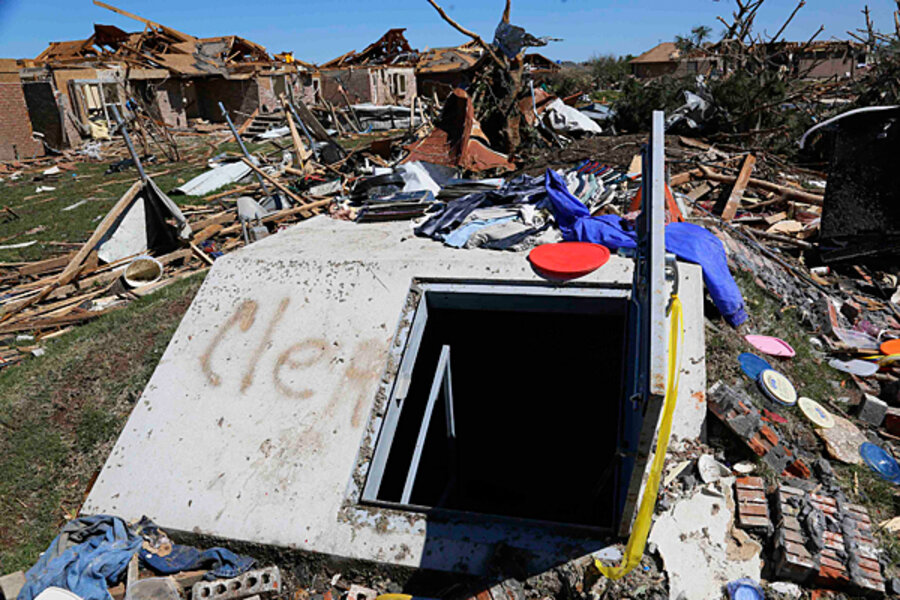Time to require tornado shelters in Oklahoma? Moore's mayor says yes.
Loading...
| Moore, Okla.
As some 33,000 tornado-battered residents of Moore, Okla., were allowed back into their flattened neighborhoods Wednesday, the full costs of Monday's massive twister – personal, financial, social – began to emerge, with implications for change in individual lives as well as public policy.
"We always rebuild, but we may have do it differently," storm survivor Stephen Hall said Wednesday.
It was unheard of for a single city to be struck by two massive EF5 tornadoes, and Moore has the unhappy badge of being the first, notes tornado historian Thomas Grazulis. The Oklahoma City suburb was hit first in May 1999 and again on Monday, when a mile-wide twister dragged along for nearly 20 miles, destroying or damaging some 13,000 homes and killing 24 people, including 10 children. An EF5 tornado contains winds in excess of 200 miles per hour and is considered unsurvivable unless people shelter below ground level. A 303 m.p.h. gust recorded in the 1999 Moore tornado remains the highest wind speed recorded on the planet.
The question here is not whether to rebuild, but how, and it began on Wednesday to dominate discussion among residents and elected officials as they surveyed the enormity of the damage.
True to form in "tornado alley," another line of severe thunderstorms rolled across the city Thursday, hampering cleanup. Hail 1-1/2 inches wide was reported in Cleveland County, near where Monday's tornado touched down, and flash flood warnings were in effect throughout central Oklahoma, where as much as 2 inches of rain were expected.
On Wednesday, Glenn Lewis, mayor of this city of 56,000, said he would seek to mandate that new home construction in Moore have underground storm shelters, which adds about $4,000 to construction costs per household. After the 1999 tornado, the city helped residents get federal aid if they wanted to build shelters, but an ordinance mandating shelters would significantly boost the city's level of precaution. Mr. Lewis was also mayor during the 1999 tornado.
About 20 percent of homes in Oklahoma already have storm shelters of some sort. As the debate begins over whether to require them for housing built in Moore, on one hand is this area's proclivity for nasty weather, and on the other are the facts that just 1 in 1,000 tornadoes packs the "total destruction" punch of an EF5 and that the likelihood of such a twister striking twice or more in one place is almost nil.
At the state level, meanwhile, Oklahoma legislators are expected to consider mandating in-ground storm shelters for schools built in the future, given the outpouring of concern about the seven children who died while hunkered down at Moore's Plaza Tower Elementary School. Only one state, Alabama, now requires such shelters at schools. However, more than 100 schools in Oklahoma do have underground storm shelters.
Damage estimates began to inch upward of $2 billion. The record to date is $2.8 billion, caused by the tornado that struck Joplin, Mo., in 2011, killing 158 people.
President Obama this week offered federal help to rebuild, saying, "You will not travel that path [to recovery] alone." A funding fight with Republicans, however, may arise over how to offset the rebuilding costs.
Private markets, too, hinted that the kind of repeat destruction seen in Moore will affect the casualty and loss business. Analysts expect that insurance companies, after several years of taking major hail losses in the state, would begin to adjust rates upward.
Like the tornado in 1999, the one Monday raced across Oklahoma City's southern suburbs, site of much middle-class growth in recent years. Given the destruction, residents marveled Wednesday that more people didn't perish. Those who didn't seek safety in shelters or safe rooms survived mainly by fleeing by car, residents said.
For many here, the political debate over building codes and federal funding pales in comparison to the real tasks at hand, including clearing massive debris fields and, more important, paying respects to the dead. Oklahomans begin burying victims on Thursday. The youngest was four months old, the oldest 70, according to CNN.






